Abstract
Sensing the deformation of soft sensor elastomer can realize the flexible operation of soft robot and enhance the perception of human-computer interaction. The structural configuration of elastomer and its elastic deformation force transfer path are crucial for decoupling sensing and studying the sensing performance of three-dimensional force soft sensor. In this article, we present a theoretical method for soft sensor with three-dimensional force decoupling-sensing. First, the constraint types of parallel manipulator with three translational motion characteristics are analyzed and used to set the constraint conditions for topology optimization. In addition, the differential kinematic modeling method is adopted to establish the differential kinematic equation of the three translations parallel manipulator, which is used as a pseudo-rigid body model for sensor information perception. Second, combining the kinematic Jacobi matrix with solid isotropic material with penalization the (SIMP), the topological model is built for designing of sensor elastomer. We optimized the composition of the material and evaluate the model’s sensing capabilities. The results validate a elastomer of soft sensor for unity between structural stiffness and perceived sensitivity.
Keywords:
soft sensor; structural configuration of elastomer; three-dimensional force decoupling sensing; topology optimization MSC:
93-08
1. Introduction
Soft robot is made of flexible materials, such as silicone rubber [1], gelatin-glycerol hydrogel [2], and so on, which can change its size at will. Compared with rigid robot, soft robot has the characteristics of high compliance, adaptability and safety, and it has broad application prospects in flexible intelligent manufacturing, precision medical treatment and rehabilitation, ocean exploration, aerospace and other important fields [3]. The continuum robot with Young’s modulus of Pa– Pa becomes a soft robot [4], and its configuration has infinite degrees of freedom (DOF) due to good compliant deformation movement. However, some dynamic characteristics and the underactuated characteristics of disturbance can not be controlled in nature, for example, endoscopic surgery under the control system of powerless perception may cause damage to other tissues and organs [5], and real-time feedback control can not be realized [6]. Because the rigid sensor will destroy the soft elasticity and flexibility of the soft robot as a whole, at present, the stretchable flexible sensor is usually used to cover the surface of the soft driver, and the tactile sensing information feedback is realized through the detection of voltage, current and curvature, rather than using the internal sensor to obtain more accurate values [7]. With the development of flexible wearable sensor technology, by simulating the dermal tissue structure and the sense and touch principle of electronic skin to external pressure, researchers have proposed the configuration composition of array [8] and cascade [9,10] flexible sensors, in order to solve the technical problem of multi-dimensional strain identification and perception extending from uni-axial deformation or multi-dimensional strain in two dimensional plane to three dimensional space. The multi-dimensional force sensor is composed of force bearing end, elastomer, force sensitive elements (such as resistance, capacitance, piezoelectric and other strain gauges) and corresponding circuits. The vector force is applied by the outside acts on the force bearing end, causing the elastomer to deform, which is transformed into an electrical signal by the force sensitive element and output by the detection circuit. The deformation (size and direction) of the elastomer directly affects the sensing performance of the sensor (sensitivity, state sensing, system response and stability, etc.), and the in-depth disclosure of its configuration composition principle and mechanical mechanism will make the flexible sensor get rid of the use of rigid materials, and realize the mechanical interface level fusion between the flexible sensor and the soft robot, so as to achieve the real “soft” in the sense. The configuration of flexible sensor elastomers such as an array type, laminated type, origami structure and spatial mechanism fails to essentially solve the problem of three-dimensional force flexible decoupling sensing of soft sensors [11,12,13], which is specifically shown as follows:
- (1)
- The traditional laminated flexible sensor adopts a three-layer structure filled with a flexible substrate, force sensing element and composite material. The mechanical mismatch between the filling material and the flexible substrate, weak interlayer adhesion and interface defects hinders the improvement of the flexibility and electromechanical performance of the composite material [14].
- (2)
- The configuration composition of elastomer and its vector force decoupling sensing mechanism is not clear, and the arrangement position of force sensing elements lacks theoretical basis [15,16].
- (3)
- There has a “symbiotic contradiction” between the overall structural stiffness and the sensing sensitivity of the flexible sensor, which seriously restricts the development of the soft sensor technology [17].
Topology optimization is a mathematical method based on the finite element theory to optimize the material distribution in a given region according to the given load conditions, constraints and performance indicators [18]. In order to solve the problem of “symbiotic contradiction” between structural stiffness and high sensing sensitivity, the volume fraction of nano-particles in the matrix was controlled, and the structural stiffness and strain sensitivity we taken as optimization objectives, the perforated plate structure was designed by Seifert et al. [19]. Nguyen et al. [20] proposed a robot joint torque sensor with a through-hole spoke topology of the inclination sensing surface and a strain gauge, and optimized the design to improve the configuration position and concentrated stress distribution of the strain gauge, so as to improve the sensitivity of the sensor on the premise of ensuring the stiffness. Inspired by the perspective of spatial mechanism, the external force is detected and output through the sensing elements configured by the elastomer, and the number of sensing elements configured should correspond to the vector of the external force [21,22,23]. To realize the detection of three sensor information including bending and torsion, Youn et al. [24] adopted the structural design method of three polymer coil wound sensors, and deduced the relationship between the sensor output and the three degree-of-freedom (DOF) configuration of the flexible manipulator through artificial neural network. From different perspectives, researchers have proposed diverse configurations of elastomers, such as origami structure [25,26], cantilever structure [27], flexure hinge structure [28,29,30], parallel mechanism [31,32]. In view of topology optimization literature including anisotropic material [33,34], spatial multi-DOF [35,36], etc., a soft sensor elastomer design method combining topology optimization with structural configuration principle of spatial mechanism is proposed in this paper. The main contributions of this paper are summarized as follows:
- (1)
- In order to solve the “symbiotic contradiction” between the support stiffness and the perceived sensitivity of elastomers, an elastomer configuration synthesis method based on topology optimization is proposed.
- (2)
- Taking the three DOF parallel manipulator with pure rotational characteristics as the prototype, by combining its dynamic Jacobi matrix with the topology optimization method, the isomorphic topological structure of the elastomer is obtained, and the three-dimensional force decoupling perception is realized through the dynamic inverse solution of the parallel prototype manipulator.
- (3)
- Combining the dynamic Jacobin gradient matrix with anisotropic composites, the transmission of three-dimensional force acting on the end face of the soft sensor in the elastomer is realized, and the transmission path of the forces and the configuration position of the sensing element are determined.
The rest of this paper is structured as follows: In Section 2, the constraint type of three-translational moving characteristics is analyzed, and the kinematic Jacobi matrix is derived for mapping the elastic deformation of soft sensor. The topology optimal method combining SIMP with kinematic Jacobi matrix is proposed, and the topological model is derived in Section 3. Numerical experiment results are reported to demonstrate the effectiveness of the proposed method in Section 4. Finally, conclusions are provided in Section 5.
2. Description of Three-Dimensional Force Perception
The three-dimensional force sensor is composed of an elastic element, a sensing element and a bridge circuit, and the measured force acts on the elastic element to deform it and generate a strain. The strain proportional to the force is converted into a resistance change by the sensing element, and the resistance change is converted into current or voltage output value by the bridge circuit. It can be seen that the decomposition of the three-dimensional vector moment in space is determined by the configuration of the elastic element. According to the corresponding relationship between the constraint type and the motion characteristics (macroscopic displacement caused by strain), the spatial mechanism that can realize the three pure rotational motion characteristics can be used as the elastic element structure type of the three-dimensional torque sensor. The theory of reciprocal screws was used for the enumerating of the feasible limb structures of a class of 3-DOF rotational parallel manipulators in [37]. The 3-UPC type parallel mechanism is selected as prototype mechanism. The vector constraint type and kinematic of the prototype mechanism are analyzed for topology optimization constraint form and the mapping relationship between the three-dimensional torque acting on the elastic body and the micro strain.
2.1. Analysis of Constraint Types in Topology Optimization
The 3-UPC type parallel prototype manipulator is composed by a moving platform, fixed platform and three symmetrical links. Each link is composed by a universal joint which connected with the fixed platform, a cylindrical joint which connected with the moving platform, and an actuated prismatic joint is used to connect the universal joint with cylindrical joint. Its structural configuration is shown in Figure 1a. According to the kinematic characteristics analysis in [37], the 3-UPC type parallel manipulator has three pure rotational motion characteristics. The coordinate system is fixed to the fixed platform. The connection point of the limb lying on the fixed platform and the moving platform are denoted by and , respectively. The moving and fixed platform are in the shape of an equilateral triangle, and the lengths are b and a, as shown in Figure 1b.
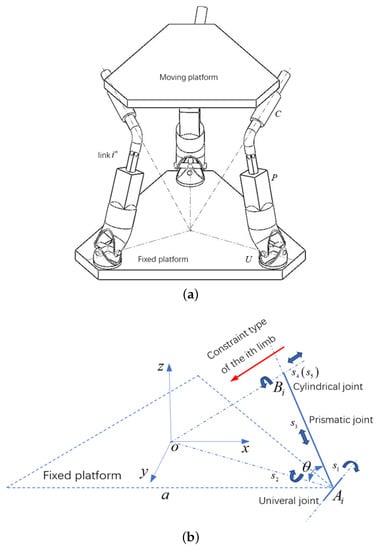
Figure 1.
Prototype structure and constraint types of the parallel manipulator with three-translation DOF. (a) The overview of prototype structure between the fixed platform and moving platform. (b) Constraints of the prototype structure joints.
According to the screw theory, the screw system of link 1th can be expressed as
Considering the reciprocal screw systems by using , we obtain
Remark 1.
, it indicates that the constraint type of the links to the moving platform are pure force constraint.
Remark 2.
, it indicates that the constraint force direction is consistent with the axis direction of the cylinder joint.
2.2. Elastic Deformation Transmission of Jacobi Matrix
Assume that the three kinematic rotational parameters are , and , respectively. The initial topological convergence conditions is set as , without loss of generality, the following approximation are adopted: and , and . The above hypothesis applies equally to and . The moving platform rotates around the three force intersection point, and the rotation transformation matrix is given by
where and . As the prismatic joint is driver, and the value of displacement actuated is , the vector equation is presented as
Multiplying the rotational transformation matrix, transformed coordinate of is calculated, yields to
Substituting the original coordinate frames into (7), the kinematic Jacobin matrix is derived as follows
where is the kinematic Jacobin matrix, which can be used as elastic deformation transmission combined with topological algorithm.
3. Topology Optimization of Soft Sensor
3.1. Topological Model with Displacement Sensitivity Analysis
The linear static kinematic with the finite element analysis is given by
where K is the total stiffness matrix of structure, u is the total displacement vector of structure, and F is the vector of load. Derivation (11) respect with the design variable, we obtain
where is the ith design variable. Considering the relationship between output displacement, node displacement and elastic body acting moment, there has
and
where is the vector of sensing distance of strain gauge, and is the iterative displacement of the ith design variable. The optimal model of the elastomer is presented as follows
where is density filter function, defined as , where j is the neighborhood of an element with volume , and is a weight factor, N is the number of elements, is volume of element, is the convergence objective of designed volume. The nodal force vector is f, and is the displacement of the design variable. is the ith element of the displacement vector, is the jth element of the displacement vector. is the stiffness of the element and is the density of the element. p is the penalty factor of the intermediate material density, and its values range is defined as follows
where is the Poisson’s ratio.
3.2. Sensitivity Analysis
Derivation the volume constraint with respect to the design variable , we obtain
where and . As the hexahedral element structure is adopted to mesh the partition grid, there has . The compliance sensitivity is satisfied with
where the nodal displacement vector is the solution of the equilibrium equation , and its derivation with respect to is satisfied with
Combining (18) and (19), we obtain
where , is positive definite. Derivation the objective function respect with the design variables, we obtain
Without loss of generality, assume that input loads independence from design variables. Derivation the design variables of (15) respect with the stiffness matrix, yields to
and
Substituting into (23), the sensitivity of objective function is derived as follows
Set the volume as the optimization constraint, the partial derivative of the volume with respect to the material density is given by
3.3. Solution of the Topological Model
Based on the variation principle, the function equation that contains the compliance, objective, and constraint functions can be built using the Lagrange multiplier. The update iteration of the multi-input-output in the three-dimensional space is given by
where is the iteration value of Kth step, is the iteration value of th step, and is the moving limit constant and is the damping factor. is expressed as
is the Lagrange multiplier with the volume constraint of kth step iteration, updated adopting bi-directional convex linear programming method, and is the element volume of kth step iteration.
4. Experiments
4.1. Material Composition and Sample Preparation
With silica gel as the main material, we made five kinds of samples by adding different proportions of glass fiber to enhance the stiffness of the material, and conducted tensile test to obtain their respective modulus of elasticity, as shown in Figure 2.
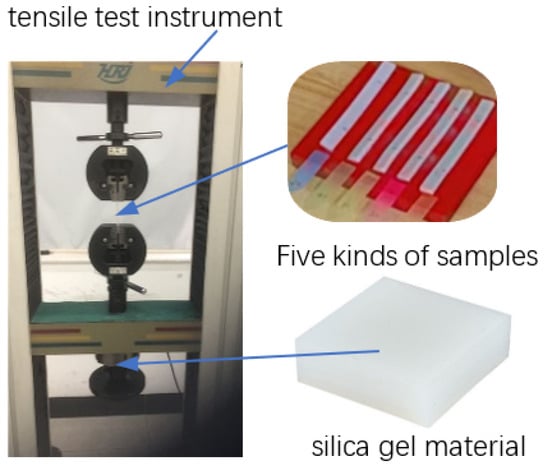
Figure 2.
Tensile test of silica gel with different proportions of glass fiber.
The WDW-S50 tensile testing machine with an accuracy level of 1 has been used in the experimental tests. The sample size is 90 mm long, 10 mm wide and 3 mm thick, and the length of the working part is 50 mm. The formula for calculating the elastic modulus is
where E is the elastic modulus, MPa; F is the load, N; is the length of the working part, mm; is the length of th working part after loading, mm; h is the width of the sample, mm; b is the thick of the sample, mm. The elastic modulus of samples with different proportions of glass fibers is calculated as shown in Table 1.

Table 1.
Elastic modulus of samples with different proportions of glass fibers.
The experimental results show that glass fiber plays a strengthening effect in silica gel. As the proportion of glass fiber increases, the elastic modulus changes as shown in Figure 3.
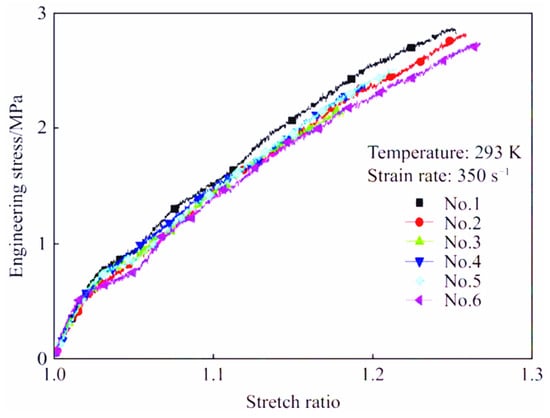
Figure 3.
Elastic modulus of silica gel with different percentages glass fiber.
The tensile stress gradually decreases after . In this paper, glass fiber and silica gel mixture is adopted as soft sensor elastomer material composition.
4.2. Topological Configuration of Elastomers
The design domain is a prismatic of dimension at the basement, and at the moving platform, and height is . It is discredited with 2000 eight-node elements with a hexahedral structure. The composition material of the elastomer is defined with Young’s modulus of 1.244 Mpa and Poisson’s ratio of 0.3. The three force inputs are assumed as 10 N, and the volume restriction is of the given design domain. Figure 4 displays the convergence process, and the stress nephogram is shown in Figure 5, respectively.
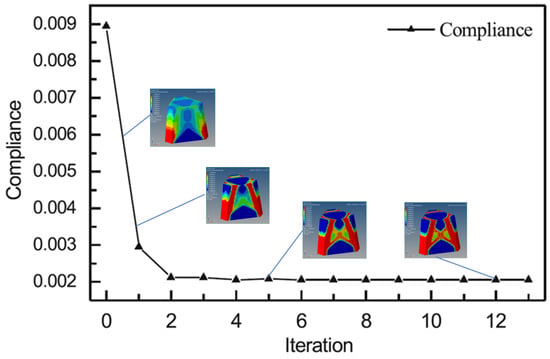
Figure 4.
Topological convergence process.

Figure 5.
Stress nephogram of the elastomer with topological structure. (a) x axis direction. (b) y axis direction. (c) z axis direction.
Figure 5 shows that the stress nephogram of an elastomer with topological configuration in x, y and z directions. The maximum stress are Mpa, Mpa and Mpa along with x, y and z direction, respectively. The minimum stress are Mpa, Mpa, and Mpa along with x, y and z direction, respectively. The displacement values of the elastomer with topological structure are shown in Table 2.

Table 2.
Displacement values of the elastomer.
4.3. Sensitivity of Soft Sensor
The experiment platform for sensitivity of soft sensor is built, as shown in Figure 6.
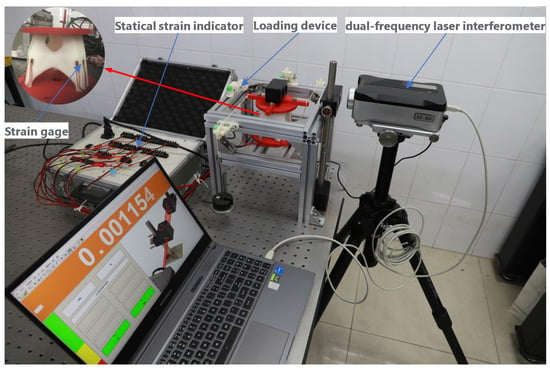
Figure 6.
Experiment platform for sensitivity of soft sensor.
The type of resistance strain gauge is selected as 120-5AA, the resistance value is 120 ohm, and the size of wire grid is mm. ASM9-4 static strain acquisition system is adopted, ADC resolution is 24 bits, signal sampling rate is 20, strain measurement range is −60,000+60,000 , nonlinearity is less than , strain measurement resolution is 0.1 . The experimental data of soft sensor x, y and z axes directions are derived as shown in Figure 7.
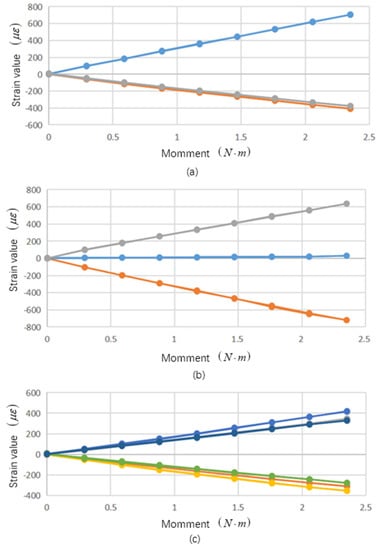
Figure 7.
Correspondence between strain values and load. (a) x axis direction. (b) y axis direction. (c) z axis direction.
The resistance strain gauge collected data through the static strain gauge, and the deformation value of the elastomer under stress is obtained as shown in Figure 7. When the loading torque changes from 0 to 2.5 N·m, the changes of the three groups of resistance strain gauges used to detect the and directions are shown in Figure 7a,b, and the changes of the six groups of resistance strain gauges used to detect the direction are shown in Figure 7c, showing good linearity. It shows that topological elastomer, as a soft sensor of soft robot, has three dimensional vector decoupling sensitivity. The decoupling principle can be analyzed and calculated according to (5).
5. Conclusions
Recently, soft sensor with their potential applications have a major role in flexible intelligent manufacturing, precision medical treatment and engineering. In this paper, we introduce a theoretical method for soft sensor with three-dimensional force decoupling-sensing. Also, we present the prototype structure according to the parallel manipulator with three-translational DOF, and its Jacobin matrix is used to construct the topological algorithm combining with SIMP. Further, the material properties are considered to form the structure of the soft sensor. Numerical experiment results validate the effectiveness of the proposed design strategy. The results appear in this paper are seemed new to the literature.
Author Contributions
Methodology and conceptualization, D.Z. and L.W.; data curation and writing-orginal draft, D.Z.; investigation and visualization, Y.H.; validation, writing-reviewing and editing, D.Z., L.W. and Y.H. All authors have read and agreed to the published version of the manuscript.
Funding
This research was funded by the University Scientific Research Project of Education Bureau of Guangzhou Municipality under Grant 202032821 and Guangzhou City School Joint Project under Grant SL2023A03J00681.
Data Availability Statement
The corresponding author will provide the data used in this work upon reasonable request.
Acknowledgments
The authors extend their appreciation to the Bureau of Education of Guangzhou Municipality for funding this work through the University Scientific Research Project of Education Bureau of Guangzhou Municipality under Grant 202032821.
Conflicts of Interest
The authors announce that they have no conflict of interest.
References
- Jiao, Z.D.; Zhang, C.; Wang, W.; Pan, M.; Yang, H.Y.; Zou, J. Advanced artificial muscle for flexible material-based reconfigurable soft robots. Adv. Sci. 2019, 6, 1901371. [Google Scholar] [CrossRef]
- Hardman, D.; Hughes, J.; Thuruthel, T.G.; Gilday, K.; Lida, F. 3D printable sensorized soft gelatin hydrogel for multi-material soft structures. IEEE Robot. Autom. Lett. 2021, 6, 5269–5275. [Google Scholar] [CrossRef]
- Shah, D.S.; Powers, J.P.; Tilton, L.G.; Kriegman, S.; Bongard, J.; Kramer-Bottiglio, R. A soft robot that adapts to environments through shape change. Nat. Mach. Intell. 2019, 3, 51–59. [Google Scholar] [CrossRef]
- Elango, N.; Faudzi, A.A.M. A review articl: Investigations on soft materials for soft robot manipulators. Int. J. Adv. Manuf. Technol. 2015, 80, 1027–1037. [Google Scholar] [CrossRef]
- Wei, Y.Z.; Xu, Q.S. Design and testing of a new force-sensing cell miroinjector based on flexure mechanism. IEEE Sens. J. 2019, 19, 6012–6019. [Google Scholar] [CrossRef]
- Dawood, A.; Fras, J.; Aljaber, F.; Mintz, Y.; Arezzo, A.; Godaba, H.; Althoefer, K. Fusing dexterity and perception for soft robot-assisted minmally invasive surgery: What we learnt from STIFF-FLOP. Appl. Sci. 2021, 11, 6586. [Google Scholar] [CrossRef]
- Zhu, Y.T.; Giffney, T.; Aw, K. A dielectric elastomer-based multimodal capacitive sensor. Sensors 2022, 22, 622. [Google Scholar] [CrossRef]
- Ge, J.; Wang, X.; Drack, M.; Volkov, O.; Liang, M.; Bermudez, G.S.C.; Llling, R.; Wang, C.A.; Zhou, S.Q.; Fassbender, J.; et al. A bimodal soft electronic skin for tactile and touchless interaction in real time. Nat. Commun. 2019, 10, 4405. [Google Scholar] [CrossRef]
- Li, D.F.; He, J.H.; Song, Z.; Yao, K.M.; Wu, M.G.; Fu, H.R.; Liu, Y.M.; Gao, Z.; Zhou, J.K.; Wei, L.; et al. Miniaturization of mechanical actuators in skin-integrated electronics for haptic interfaces. Microsyst. Nanoeng. 2021, 7, 85. [Google Scholar] [CrossRef]
- Robertson, M.A.; Kara, O.C.; Paik, J. Soft pneumatic actuator-driven origami-inspired modular robotic “pneumagami”. Int. J. Robot. Res. 2021, 40, 72–85. [Google Scholar] [CrossRef]
- Yan, Y.C.; Hu, Z.; Yang, Z.B.; Yuan, W.Z.; Song, C.Y.; Pan, J.; Shen, Y.J. Soft magnetic skin for super-resolution tactile sensing with force self-decoupling. Sci. Robot. 2021, 6, eabc8801. [Google Scholar] [CrossRef] [PubMed]
- Xie, S.P.; Zhang, Y.F.; Zhang, H.; Jin, M.H. Development of triaxis electromagnetic tactile sensor with adjustable sensitivity and measurement range for robot manipulation. IEEE Trans. Instrum. Meas. 2022, 71, 7502409. [Google Scholar] [CrossRef]
- Rehan, M.; Slaeem, M.M.; Tiwana, M.I.; Shakoor, R.I.; Cheung, R. A soft multi-axis high force range magnetic tactile sensor for force feedback in robotic surgical systems. Sensors 2022, 22, 3500. [Google Scholar] [CrossRef] [PubMed]
- Zhang, Y.; Yang, J.L.; Hou, X.Y.; Li, G.; Wang, L.; Bai, N.N.; Cai, M.K.; Zhao, L.Y.; Wang, Y.; Zhang, J.M.; et al. Highly stable flexible pressure sensors with a quasi-homogeneous composition and interlinked interfaces. Nat. Commun. 2022, 13, 1317. [Google Scholar] [CrossRef]
- Wang, H.; Yan, B.; Liang, L. A 3D FBG accelerometer based on two pairs of flexible hinges. IEEE Sens. J. 2021, 21, 21586–21593. [Google Scholar] [CrossRef]
- Yuan, X.B.; Wou, S.M.; Han, M.D.; Wang, Y.S.; Rogers, J.A.; Huang, Y.G.; Wang, H.L. Mechanics of encapsulated three-dimensional structures for simultaneous sensing of pressure and shear stress. J. Mech. Phys. Solids 2021, 151, 104400. [Google Scholar] [CrossRef]
- Zou, Q.; Wang, Y.D.; Yang, F.R. An intrinsically embedded pressure-temperature dual-mode soft sensor towards soft robotics. Sens. Actuators A-Phys. 2021, 332, 113084. [Google Scholar] [CrossRef]
- Bendsoe, M.P.; Sigmund, O. Topology Optimization: Theory, Methods, and Applications; Springer: Berlin/Heidelberg, Germany, 2004. [Google Scholar]
- Seifert, R.; Patil, M.; Seidel, G. Topology optimization of self-sensing nanocomposite structures with design boundary conditions. Smart Mater. Struct. 2019, 28, 074006. [Google Scholar] [CrossRef]
- Nguyen, D.D.; Kuo, C.H. Design and optimization of a joint torque sensor for lightweight robots. IEEE Sens. J. 2021, 21, 9788–9797. [Google Scholar] [CrossRef]
- Li, Y.J.; Xu, X.S.; Wang, G.C.; Cao, S.K.; Chen, N.J.; Sun, X. Fault-tolerant measurement mechanism research on pre-tightened four-point supported piezoelectric six-dimensional force/torque sensor. Mech. Syst. Signal Process. 2020, 135, 106420. [Google Scholar] [CrossRef]
- Zeng, X.W.; Liu, Y.D.; Liu, F.M.; Wang, W.Y.; Liu, X.Y.; Wei, X.D.; Hu, Y.F. A bioinspired three-dimensional integrated e-skin for multiple mechanical stimuli recognition. Nano Energy 2022, 92, 106777. [Google Scholar] [CrossRef]
- Wang, S.; Wang, C.Y.; Lin, Q.J.; Zhang, Y.X.; Zhang, Y.J.; Liu, Z.J.; Luo, Y.Y.; Xu, X.Y.; Han, F.; Jiang, Z.D. Flexible three-dimensional force sensor of high sensing stability with bonding and supporting composite structure for smart devices. Smart Mater. Struct. 2021, 30, 105004. [Google Scholar] [CrossRef]
- Youn, J.H.; Mun, H.; Jang, S.Y.; Kyung, K.U. Highly stretchable-compresible coiled polymer sensor for soft continuum manipulator. Smart Mater. Struct. 2022, 31, 015043. [Google Scholar] [CrossRef]
- Liu, X.Y.; Li, C.L.; Wang, Z.T.; Li, Y.F.; Huang, J.Q.; Hu, H.Y. Wide-range flexible capacitive pressure sensors based on origami structure. IEEE Sens. J. 2021, 21, 9798–9807. [Google Scholar] [CrossRef]
- Mintchev, S.; Salerno, M.; Cherpillod, A.; Scaduto, S.; Paik, J. A portable three-degrees-of-freedom force feedback origami robot for human-robot interactions. Nat. Mach. Intell. 2019, 1, 584–593. [Google Scholar] [CrossRef]
- Grogan, C.; McGovern, F.R.; Staines, R.; Amarandei, G.; Naydenova, I. Cantilever-based sensor utilizing a diffractive optical element with high sensitivity to relative humidity. Sensors 2021, 21, 1673. [Google Scholar] [CrossRef]
- Li, J.Y.; Cui, J.W.; Tan, J.B. Design of three-dimensional isotropic microprobe based on three-flexible-hinge suspension for measurement of microstructures. IEEE/ASME Trans. Mechatron. 2020, 25, 2123–2133. [Google Scholar] [CrossRef]
- Liu, X.B.; Liang, L.; Jiang, K.; Xu, G. Sensitivity-enhanced fiber bragg grating pressure sensor based on a diaphragm and hinge-lever structure. IEEE Sens. J. 2021, 21, 9155–9164. [Google Scholar] [CrossRef]
- Lin, Y.W.; Efimovskaya, A.; Shkel, A.M. Folded MEMS platform based on polymeric flexible hinges for 3D integration of spatially-distributed sensors. J. Microelectromech. Syst. 2021, 30, 907–914. [Google Scholar] [CrossRef]
- Jamil, B.; Rodrigue, H.; Choi, Y. Design of a novel sensing method for a pneumatic artificial muscle actuator-driven 2-Degrees of freedom parallel joint. Soft Robot. 2022. [Google Scholar] [CrossRef]
- Kumar, K.S.; Xiao, X.; Kalairaj, M.S.; Ponraj, G.; Li, C.S.; Cai, C.J.; Lim, C.M.; Ren, H.L. Omnidirectional steerable forceps with flexible joints and skin-like stretchable strain sensors. IEEE-ASME Trans. Mechatron. 2022, 27, 713–724. [Google Scholar] [CrossRef]
- Li, D.Z.; Kim, I.Y. Modified element stacking method for multi-material topology optimization with anisotropic materials. Struct. Multidiscip. Optim. 2020, 61, 525–541. [Google Scholar] [CrossRef]
- Harvey, D.; Hubert, P. 3D topology optimization of sandwich structures with anisotropic shells. Compos. Struct. 2022, 285, 115237. [Google Scholar] [CrossRef]
- Zhou, Y.Q.; Nomura, T.; Zhao, E.P.; Saitou, K. Large-scale three-dimensional anisotropic topology optimization of variable-axial lightweight composite structures. J. Mech. Des. 2022, 144, 011702. [Google Scholar] [CrossRef]
- Liang, K.X.; Zhu, D.C.; Liu, J. Topology optimization of a spatial compliant parallel mechanism based on constant motion transmission characteristic matrix. Mech. Mach. Theory 2022, 180, 105125. [Google Scholar] [CrossRef]
- Fang, Y.F.; Tsai, L.W. Structure synthesis of a class of 3-DOF rotational parallel manipulators. IEEE Trans. Robot. Autom. 2004, 20, 117–121. [Google Scholar] [CrossRef]
Disclaimer/Publisher’s Note: The statements, opinions and data contained in all publications are solely those of the individual author(s) and contributor(s) and not of MDPI and/or the editor(s). MDPI and/or the editor(s) disclaim responsibility for any injury to people or property resulting from any ideas, methods, instructions or products referred to in the content. |
© 2023 by the authors. Licensee MDPI, Basel, Switzerland. This article is an open access article distributed under the terms and conditions of the Creative Commons Attribution (CC BY) license (https://creativecommons.org/licenses/by/4.0/).